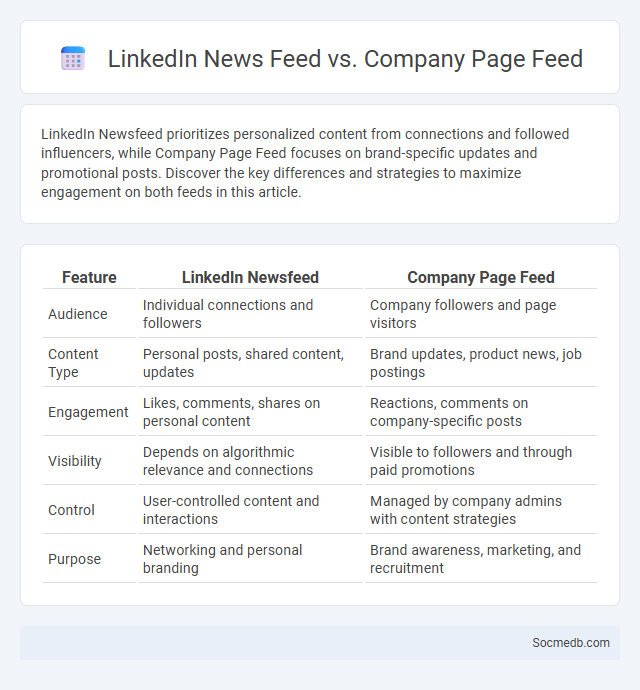
Photo illustration: LinkedIn Newsfeed vs Company Page Feed
LinkedIn Newsfeed prioritizes personalized content from connections and followed influencers, while Company Page Feed focuses on brand-specific updates and promotional posts. Discover the key differences and strategies to maximize engagement on both feeds in this article.
Table of Comparison
| Feature | LinkedIn Newsfeed | Company Page Feed |
|---|---|---|
| Audience | Individual connections and followers | Company followers and page visitors |
| Content Type | Personal posts, shared content, updates | Brand updates, product news, job postings |
| Engagement | Likes, comments, shares on personal content | Reactions, comments on company-specific posts |
| Visibility | Depends on algorithmic relevance and connections | Visible to followers and through paid promotions |
| Control | User-controlled content and interactions | Managed by company admins with content strategies |
| Purpose | Networking and personal branding | Brand awareness, marketing, and recruitment |
Understanding the Basics: LinkedIn Newsfeed, Company Page Feed, and Newsfeed
LinkedIn's newsfeed aggregates content from connections, followed companies, and industry influencers, promoting professional engagement and knowledge sharing. Company page feeds serve as a dedicated platform for brands to post updates, share industry insights, and engage with their target audience, boosting brand visibility and credibility. Understanding the distinction between a personal newsfeed and a company page feed enables users to strategically navigate LinkedIn for networking, marketing, and content discovery.
Purpose and Functionality: LinkedIn Newsfeed vs Company Page Feed
LinkedIn Newsfeed serves as a dynamic stream of personalized updates, industry insights, and network interactions tailored to each user's professional interests and connections. The Company Page Feed functions as a centralized hub for brand-specific content, including announcements, product launches, and employer branding aimed at engaging followers and potential clients. Both features optimize professional networking but target different audience engagement strategies: personalized content discovery versus brand-focused communication.
Content Visibility: What Gets Seen and Where
Content visibility on social media is largely determined by platform algorithms that prioritize engagement metrics such as likes, shares, and comments. Posts with high interaction rates are more likely to appear in users' feeds, Stories, and Explore pages, amplifying reach across networks like Instagram, Facebook, and TikTok. Strategic use of hashtags, posting times, and multimedia content further enhances visibility by targeting niche audiences and maximizing platform-specific exposure.
Audience Targeting: Reaching the Right Viewers
Precise audience targeting on social media platforms harnesses demographic data, user behavior, and interests to deliver content directly to the most relevant viewers. Utilizing advanced algorithms and tools like Facebook Ads Manager, Instagram Insights, and LinkedIn Matched Audiences enables marketers to optimize ad spend and increase engagement rates. Effective targeting leads to higher conversion rates and improved return on investment (ROI) by connecting brands with users most likely to engage and convert.
Engagement Metrics: Comparing Interaction Levels
Engagement metrics such as likes, comments, shares, and click-through rates provide critical insights into the interaction levels of your social media content. Platforms like Instagram, Facebook, and Twitter each display varying engagement rates based on audience behavior and content type. Analyzing these data points allows you to optimize your social media strategy for higher user interaction and improved visibility.
Content Control: Who Can Post and Share
Content control on social media platforms ensures that you can manage who has the ability to post and share within your network, enhancing security and relevance. Setting permissions allows you to restrict content creation to trusted users or select groups, minimizing spam and inappropriate posts. Effective control mechanisms empower you to maintain a curated, high-quality social media environment aligned with your brand or community values.
Algorithm Insights: How Feeds Prioritize Content
Social media algorithms prioritize content based on your interaction patterns, engagement rates, and post relevance to maximize user retention and satisfaction. These algorithms analyze factors like likes, comments, shares, and viewing time to curate personalized feeds that heighten user experience. Understanding these algorithm dynamics empowers you to create content that resonates and achieves greater visibility.
Branding Opportunities: Company Page Feed vs Personal Newsfeed
Your company page feed offers targeted branding opportunities by showcasing curated content aligned with your brand identity, enhancing professional credibility and attracting potential clients. In contrast, a personal newsfeed blends diverse posts, limiting focused brand messaging but allowing more authentic engagement with your network. Leveraging the company page feed strategically amplifies your brand's visibility and reinforces consistent messaging across social media platforms.
Best Practices: Maximizing Each LinkedIn Feed
Maximizing each LinkedIn feed requires tailored content strategies that prioritize high-quality, relevant posts including industry insights, professional achievements, and engaging media such as videos and infographics. Consistent use of hashtags like #Leadership, #Innovation, and #CareerGrowth enhances post visibility and fosters targeted network interactions. Engaging with connections through comments, shares, and personalized messages boosts algorithmic ranking, driving organic reach and strengthening professional relationships.
Strategic Recommendations: Choosing the Right Feed for Your Goals
Selecting the appropriate social media feed depends on your target audience, content type, and engagement objectives. Prioritize platforms where your demographic is most active, such as Instagram for visual storytelling or LinkedIn for B2B networking, to maximize reach and interaction. Tailoring your feed strategy with consistent analytics reviews ensures alignment with evolving market trends and optimizes content impact.
 socmedb.com
socmedb.com